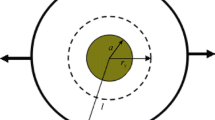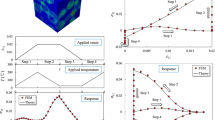Abstract
In this paper, an accurate formula for calculating the thermal residual stress field in a particle-reinforced composite are presented. Numerical examples are given to show r-variations of the thermal residual stresses. The increase in fracture toughness of matrix predicted by the thermal residual stress field is compared well with the experimentally measured increase.
Similar content being viewed by others
Explore related subjects
Discover the latest articles, news and stories from top researchers in related subjects.Avoid common mistakes on your manuscript.
Introduction
It has been recognized for some time that the dispersion of second-phase particles can increase the fracture behavior of ceramics. Whenever a multiphase microstructure experiences hot-pressing at elevated temperature, the mismatch between the coefficients of the thermal expansion and elastic constants in matrix and particle results in generation of residual stresses in particle and matrix upon cooling to room temperature. These residual thermo-elastic micromechanical stresses have always been of interest from both the strengthening and the weakening perspectives.
Selsing [1] presented a solution for the thermal residual stress of a single spherical inclusion imbedded within an infinite isotropic elastic matrix, the two having different coefficient of thermal expansion and elastic constants.
where α, E, ν are the coefficient of thermal expansion, elastic modulus and Poisson’s ratio, the subscripts m and p refer to the matrix and the particular respectively, ΔT = T R −T P, T Rand T P denote the room temperature and the processing temperature. Wei and Becher [2] consider the thermal residual stress (1) which is induced by CTE mismatch as a major cause for the crack deflection. The Eq. (1) does not contain the volume fraction of particle f p. It is a lower-order approximation to the stress in composite with a finite volume fraction of particle. Although they made no quantitative estimate of the increased toughness.
Another toughening mechanism is the thermal residual stresses in a particulate composite [3–5]. Virkar and Johnson [3] showed that micromechanical residual stresses can enhance the fracture toughness of ceramics-metal composites. However, the periodic nature of the residual stresses was not fully incorporated in the analysis in that internal stresses acting on only half the wavelength were considered. Culter and Virkar [4] postulated a periodic tension-compression residual stresses field, which was caused by CTE mismatch as the composite was cooled to room temperature, in a ZrO2–Zr composite. This periodic residual stress model was used to explain the toughness increase which was observed in the ZrO2–Zr composite. The model proposed by Evans et al. [5] and Cutler and Virkar [4] provided the fracture toughness, K IC, of a particulate due to periodic residual stress field as
where K I0 is the critical stress intensity factor of the matrix, q is the local residual compressive stress, and D is the length of the compressive stress zone which in this case is the average particulate spacing.
Equation (2) is based on a stress intensity factor solution by Tada et al. [6] for a semi-infinite two-dimensional crack with a compressive stress zone of intensity and length D. The compressive thermal residual stress in matrix is generated when the CTE of the particle exceeds that of the matrix. It was found [4] that q is a strong function of the volume fraction of second-phase particles and large values of q resulted in large K IC.
Taya et al. [7] presented a formula for calculating the average residual stresses in the particle and the matrix by using the modified Eshelby model [8] which consider a finite volume fraction of particles.
In this paper, an accurate formula for calculating the residual stresses in the particle and the matrix of the particle composite will be presented. The results show that the residual stresses distribution in the matrix outer the particle are not uniform which considered by Cutler and Virkar [4]. The average residual stress in the matrix given by Taya et al. [7] is only a part of those presented in this paper.
Analytical model
Based on the composite sphere assemblage (CSA) model given by Hanshin [9], the two-phase model and effective model shown in Fig. 1 are used to determine the effective coefficient of thermal expansion αe for particulate composites. The model is assumed to subjected to a temperature change ΔT. Introduce a spherical coordinate system with the origin at the center of the composite sphere. The general form of the thermo-elastic solutions appropriate to the two separate regions of Fig. 1a are given by [10],
where K and G are bulk modulus and shear modulus, C 1, C 3 and C 4 are constants to be determined from the continuity conditions at the interface r = a and the boundary condition at r = b:
The solution for Fig. 1b is
where K e and G e are the effective bulk modulus and shear modulus of the particle composite as given [9] and [11], C 5 is constant to be determined from the boundary condition at r = b,
The effective thermal expansion coefficient αe can be derived from equality condition u m = u e at r = b for Fig. 1a and b.
where f m = 1−f p is the volume fraction of the matrix.
The residual thermal stresses will be obtained here by using the three-phase model shown in Fig. 2. The model consists of the single composite sphere embedded in the infinite homogeneous medium of the effective properties. The solutions of the particle and the matrix are given in Eqs. (3) and (4). The solution of the effective medium is
The constants C 1,C 3,C 4,C 5 and C 6 in Eqs. (3),(4) and (7) can determined from the continuity conditions at the interface r = a and r = band the boundary condition at r→ ∞:
After some length mathematics, we get the stresses in the particle and the matrix
where
In the case of f p = 0 and f m = 1, the Eq. (16) reduces the (1). Therefore the Eq. (1) is a lower-order approximation to the stress in composite with a finite volume fraction of particle. Taya et al. [7] presented the formulas for calculating the average residual stresses in the particle and the matrix by using the modified Eshelby’s model [8]
It is clear that the average residual stress in particle is agree with Eq. (8), the stress in matrix is incomplete and only the uniform part of the stress given by Eq. (9) which is independent on the radius r.
Numerical examples
The Fig. 3 shows the numerical results for the SiC-particulate Al2O3 matrix composite. The thermal expansion coefficient, elastic modulus and Poisson’s ratio of the ceramics SiC and Al2O3 are given in Table 1. ΔT is −1630 °C. The stresses σr and σθ in the particulate are compression stresses. The radial stress σr in the matrix is compression stress and increases as r increases. But the tangential stress σθ in the matrix is tensile and decreases with the increase r.
Taya et al. [7] presented the measured increase in fracture resistance of a TiB2-particulate-reinforced SiC-matrix composite ΔK R = 2.3 Mpa m1/2. The increase in fracture resistance ΔK R predicted by using Eqs.(2) and (11) is 1.56 MPa m1/2. Figure 4 shows the residual stresses distribution of the TiB2/SiC composite. It can be seen that the σθ and σr in the particulate are tensile stresses. The radial stress σr in the matrix is tensile stress and decreases as r increases. The stress σθ in the matrix is compression stress and increases as r increases. The fracture toughness, K IC, of a particulate due to periodic residual stress field given by Eq. (9) is [5]
We get the toughness increase ΔK R = 1.74 MPa m1/2 from Eqs. (9) and (12). It is more closer the measured one.
Summary
The accurate formula for calculating the thermal residual stress field in particle-reinforced composites was presented. The increase in fracture toughness of the composite over the unreinforced matrix predicted by this formula in better agreement with the experiment [7].
References
Selsing G (1961) J Am Ceram Soc 44:491
Wei GC, Becher PF (1984) J Am Ceram Soc 67:571
Virkar AV, Johnson DL (1977) J Am Ceram Soc 60:514
Cutler RA, Virkar AV (1985) J Mater Soc 20:3557
Evans AG, Houer AH, Porter DL (1977) The Fracture Toughness of Ceramics, Proc. Int. Conf. Fract. 4th., p 529
Tada H, Paris PC, Irwin GR (1973) The Stress Analysis of Cracks Handbook; Del. Research Corp., Hellertown, PA
Taya M, Hayashi S, Kobayashi AS, Yoon HS (1990) J Am Ceram Soc 73:1382
Mori T, Tanakas K (1973) Acta Metall 21:571
Hanshin Z (1962) J Appl Mech 29:143
Timosheko S, Goodier JW (1951) Theory of elasticity, 2nd edn. McGraw Hill, New York
Christensen RM, Lo KH (1979) J Mech Phys Solids 27:315
Author information
Authors and Affiliations
Corresponding author
Rights and permissions
About this article
Cite this article
Ling, Z., Wu, YL. Thermal residual stresses in particulate composites and its toughening effect. J Mater Sci 42, 759–762 (2007). https://doi.org/10.1007/s10853-006-1449-x
Received:
Accepted:
Published:
Issue Date:
DOI: https://doi.org/10.1007/s10853-006-1449-x








